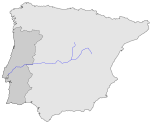Tagus
| Tagus | |
| Tajo, Tejo | |
| River | |
|
View over the Tagus River from Almourol Castle in Portugal
|
|
| Countries | Spain, Portugal |
|---|---|
| Tributaries | |
| - left | Guadiela, Algodor, Gévalo, Ibor, Almonte, Salor, Sever |
| - right | Jarama, Guadarrama, Alberche, Tiétar, Zêzere |
| Source | Fuente de García |
| - location | Albarracín Mountains, Teruel, Spain |
| - elevation | 1,593 m (5,226 ft) |
| Mouth | Stuary of the Tagus |
| - location | Atlantic Ocean at Lisbon, Portugal |
| - elevation | 0 m (0 ft) |
| Length | 1,038 km (645 mi) |
| Basin | 80,100 km² (30,927 sq mi) |
| Discharge | |
| - average | 500 m³/s (17,657 cu ft/s) |
 Path of the Tagus through the Iberian Peninsula
|
|
| Wikimedia Commons: Tagus | |
| Website: Confederación Hidrográfica del Tajo | |
The Tagus (Latin Tagus, Spanish Tajo, Portuguese Tejo, pron. IPA: ['tɛʒʊ], Ancient Greek Τάγος or Tagos) is the longest river on the Iberian Peninsula. It measures 1,038 kilometers in length, 716 km of which are in Spain, 47 km as border between Portugal and Spain and the remaining 275 km in Portugal, where it empties into the Atlantic at Lisbon. It drains an area of 80,100 km² (the second largest in the Iberian peninsula after the Douro). The Tagus is highly utilized for most of its course. Several dams and diversions supply drinking water to most of central Spain, including Madrid, and Portugal, while dozens of hydroelectric stations create power. Between dams it follows a very constricted course, but after Almourol it enters a vast alluvial valley prone to flooding. Its mouth is a large estuary forming the best harbor in Europe, on which the port city of Lisbon is situated.
The source of the Tagus is the Fuente de García, in the Albarracín mountains. All its major tributaries enter the Tagus from the right (north) bank. The main cities it passes through are Aranjuez, Toledo and Talavera de la Reina in Spain, and Abrantes, Santarém, Almada and Lisbon in Portugal.
Contents |
Course of the Tagus
The Tagus in Spain
The first notable town on the Tagus is Sacedón. Below Aranjuez it receives the combined flow of the Henares and the Tajuña. Below Toledo it receives the Guadarrama. Above Talavera de la Reina it receives the Alberche. At Valdeverdeja is the upper end of the long upper reservoir, the Embalse de Valdecañas, beyond which is the lower reservoir, the Embalse de Alcántara behind the dam, into which flow the Tiétar at the upper end and the Alagón at the lower end.
The Tagus in Portugal
After the stretch where the Tagus forms the border, it enters Portugal, passing by Vila Velha de Ródão, Abrantes, Constância, Entroncamento, Santarém and Vila Franca de Xira at the head of the long narrow estuary, which has Lisbon at its mouth. There is the largest bridge across the river, the Vasco da Gama Bridge (in Lisbon) with a total length of 17.2 km. It is also the longest bridge in Europe. The Portuguese regions of Alentejo and Ribatejo take their names from the river. Alentejo, from Além-Tejo ("beyond the Tagus"), and Ribatejo, from Arriba-Tejo (on the banks of the Tagus). There is a canal and aqueduct between the Tagus and the river.
Geology
The lower Tagus is on a fault line. Slippage along it has caused numerous earthquakes, the major ones being those of 1309, 1531 and 1755.[1]
History
The Pepper Wreck is the name of a shipwreck located and excavated at the mouth of the Tagus River between 1996 and 2001.
The Tagus in song and story
A major river, the Tagus is brought to mind in the songs and stories of the Portuguese. A popular fado song in Lisbon notes that while people get older, the Tagus remains young ("My hair getting white, the Tagus is always young"). The author, Fernando Pessoa, wrote a poem that begins: "The Tagus is more beautiful than the river that flows through my village...."[2]
Gallery
Notes
- ↑ Hobbs, William Herbert (1907). Earthquakes: An Introduction to Seismic Geology. NewYork: D. Appleton and Company. pp. pages 142-144. Downloadable Google Books
- ↑ Pessoa, Fernando; Richard Zenith, Translator (1999). Fernando Pessoa and Co.: Selected Poems. Grove Press. pp. page 55. ISBN 0802136273, 9780802136275.